
| Ford Europe |
| Ford
Australia |
| Aston
Martin (UK) - 8.3% |
Various plants in the US, Canada, Mexico and overseas.
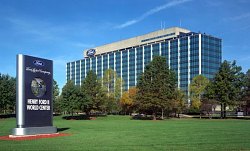
2017: 6,607,000 units
2016: 6,651,000 units
2015: 6,635,000 units
2014: 6,323,000 units
2013: 6,330,000 units
2012: 5,668,000 units
2011: 5,695,000 units
2010: 5,313,000 units
2009: 4,817,000 units
2008: 5,532,000 units
2007: 6,553,000 units
2006: 6,597,000 units
2005: 6,818,000 units
2004: 6,798,000 units
2003: 6,736,000 units
2002: 6,973,000 units
2017 US sales by brand:
Ford: 2,475,556 units
Lincoln: 111,159 units
2017 US sales by model:
Fiesta: 46,249 units
Focus: 158,385 units
C-Max: 18,390 units
Fusion: 209,623 units
Taurus: 33,242 units
Mustang: 81,866 units
GT: 89 units
Escape: 308,296 units
Edge: 142,603 units
Flex: 22,389 units
Explorer: 238,056 units
Expedition: 51,883 units
F-Series: 896,764 units
E-Series: 53,304 units
Transit: 161,833 units
MKZ: 27,387 units
MKS: 153 units
Continental: 12,012 units
MKC: 27,048 units
MKX: 31,031 units
MKT: 3,005 units
Navigator: 10,523 units
Ford operates 2 brands in its home market - Ford is for the majority people while Lincoln is the luxury brand. However, Ford did not have the required money to develop Lincoln, therefore most of its cars are usually badge-engineered versions of Ford.
Ford’s European operation and Australia arm have their own production and car development program independent of Detroit. The former is one of the European big 6 while the latter is struggling to retain its R&D and production independence. Ford used to own a third of Mazda, but in recent years it is offloading most stakes in the Japanese company and decoupling its product programs from the latter.
Henry Ford founded the company in Detroit in 1903. His early cars were named in alphabetic letters, i.e. Model A, Model B, Model C... but what changed the game was the 1908 Model T. Henry Ford engineered the car to be simple to produce and involve as few components as possible. It enabled a bargain price at only US$825, versus the average $2000-3000 of its counterparts. It didn't take too long to become the best selling car in the United States.
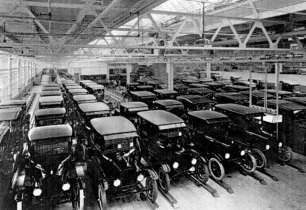 Ford's factory filled with mass production
cars
Ford's factory filled with mass production
carsHowever, the real revolution came in 1914 when Ford opened its new Highland Park factory. It employed the world's first moving assembly line. Workers no longer needed to transfer the cars from one place to another. Instead, the steadily moving assembly line transferred the cars through each station where workers carried out a simple assembly task. In this way, after a series of stations the cars were fully built. This greatly lifted efficiency, increased production capacity and lowered production cost. In prior to the move, each Model T took 12 hours to produce. Now it took only 93 minutes to leave the factory ! Ford's people consistently evaluated and improved the efficiency of assembly process. The moving assembly line allowed the production to jump to 308,000 units in 1915. As higher volume translated to lower costs, Henry was able to lower the price, which stimulated sales again. Eventually each Model T was sold at only $260, while production peaked at 2 million cars per year. This is still a record today.
Henry Ford had another contribution to the industrial revolution: he set a minimum wage of $5 per day, more than double the existing minimum rate. He explained that was not only a social revolution but also helped its employees to buy his cars ! "If you cut wages, you just cut the number of your customers", he said.
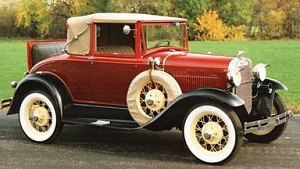 1928 Ford Model A
1928 Ford Model AIn 1922, the world no. 1 car maker bought Lincoln as its luxury car division.
By the late 1920s, Ford Model T accounted for 9 out of 10 cars in the world ! However, its Detroit rival General Motors followed its footprints quickly. Chevrolet not only provided 6-cylinder engines (while Ford offered 4) but also more new features. In contrast, to achieve maximum production efficiency, Ford sticked to its single model policy and offered few options - even no choices of color except black ! As a result, GM overtook Ford in sales chart for the first time in 1927. Ford briefly regained the title in 1929 and 30 with the new Model A, but its single model policy no longer worked, so was the Henry Ford legend. The company kept declining and lost its second place to Chrysler.
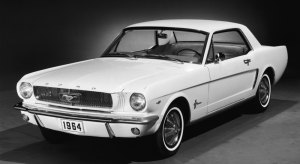 1964 Ford Mustang
1964 Ford MustangSince the end of WWII, the loss-making company started diversifying its model range. In 1949 it climbed back to the second position with a sales of 807,000 cars, the best since Model A. Its 1955 Thunderbird proved that it could catch or even lead the market trend. However, the biggest surprise was the 1964 Mustang, an inexpensive but highly upgradable sporty car. It sold 2 million copies in the first 4 and a half years and started a new trend called "pony cars".
In the 1970s, all American car makers were hit by the oil crisis and smog control regulations, hence the invasion of Japanese small cars. Ford stopped making the old-tech big cars and poured billions of dollars into new technology research. The collaboration with Mazda (which it owned minority shares) also helped developing its small cars, such as Escort. Ford coped with the 1970s better than GM.
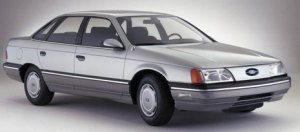 1986 Ford Taurus
1986 Ford TaurusIn 1986, Ford surprised us again with a modern mid-size car, Taurus. It beat Honda Accord to be the best selling car in the US in the early 1990s. For smaller segments, Ford tried to introduce its European Focus and Mondeo (renamed Contour) to fill the gap. Unfortunately, American customers were never warm with those cars. The radically styled second generation Taurus also fell behind its Japanese competitors. Therefore from the late 1990s Ford relied very much on the sales of its F-series pickup and Explorer SUV to subsidize its car division.
As the fever of SUV cooled down in the mid-2000s, Ford went into financial trouble again.
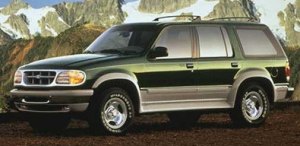 1995 Ford Explorer
1995 Ford ExplorerFord acquired Aston Martin in 1987, Jaguar in 1990, Volvo in 1998 and Land Rover in 2000. These four European car makers were integrated into PAG (Premier Automotive Group) with the aim to increase share in the premium car market. In particular, Jaguar received the biggest push, adding S-Type and X-Type in the lineup. Unfortunately, the plan was a big failure. Ford eventually sold off Aston Martin in 2007, Jaguar and Land Rover in 2008 and Volvo in 2010. Besides, it killed off the Mercury brand in 2010.